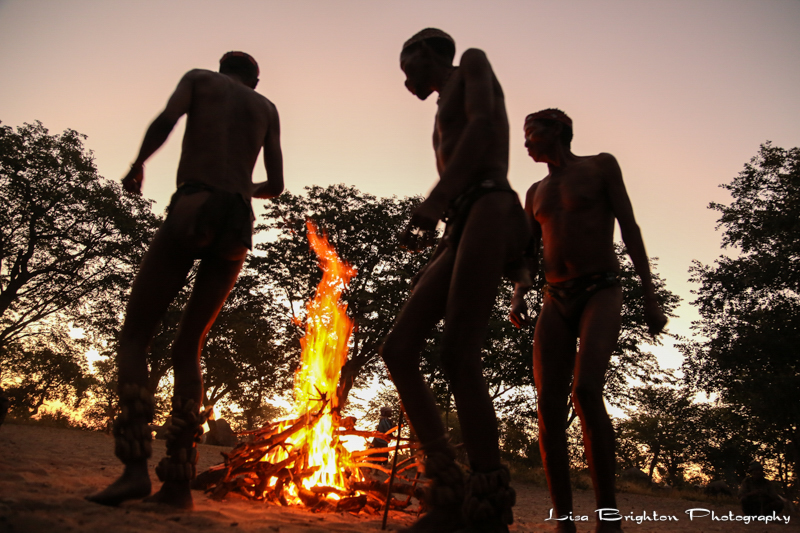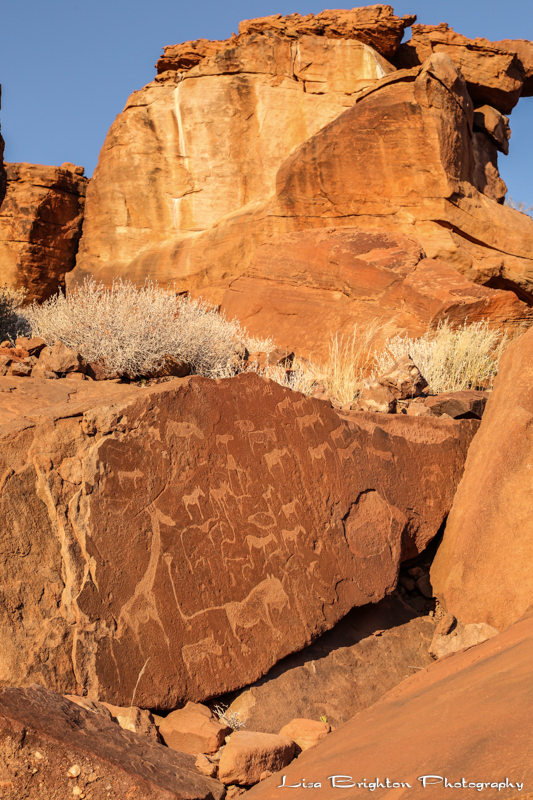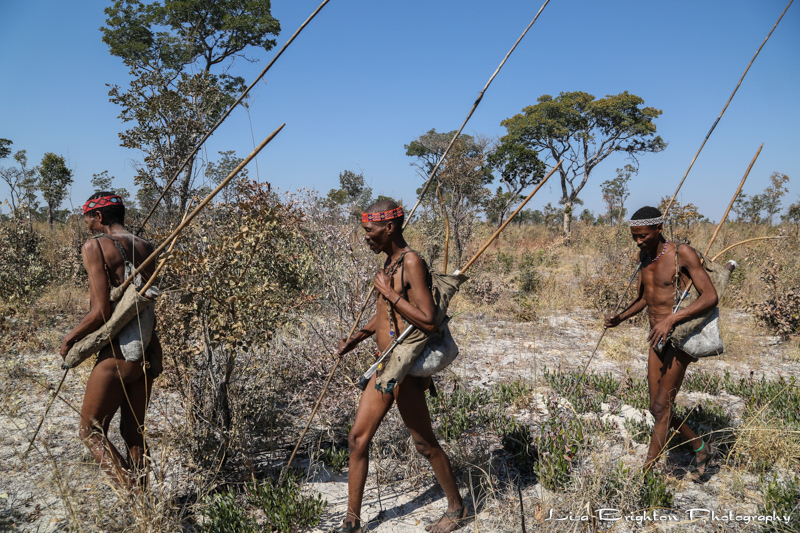7. San
 I feel the heat from the bonfire on my face. I bring my camera as low as I can in the sand and aim my lens upward toward the passionate dance in front of me. The three San Bushmen I joined on a four-hour bush walk this morning are now chanting, clapping and rhythmically move their bodies as they circle the flames. Though this might seem routine for them, especially since this tribe is thousands of years old, it is anything but normal for me. This entire day has given me a window into their lives. What an extraordinary experience it was to walk with them in the bush and see how they track animals, look for medicinal plants, and connect to the land that supports them. These three San, who go by the English nicknames of Eunice, Joseph and Mosey, are called Ikun, Nani and Ikun in their language. They told me they don’t know their ages but estimate that they are in their 50s. It doesn’t matter to them. What matters are the skills they have learned that allow them to survive in their environment. While Westernization has pushed them farther into eastern Namibia, elders have taught them how to adapt to the ever-changing world while maintaining their traditions and heritage. Evidence of their existence in
I feel the heat from the bonfire on my face. I bring my camera as low as I can in the sand and aim my lens upward toward the passionate dance in front of me. The three San Bushmen I joined on a four-hour bush walk this morning are now chanting, clapping and rhythmically move their bodies as they circle the flames. Though this might seem routine for them, especially since this tribe is thousands of years old, it is anything but normal for me. This entire day has given me a window into their lives. What an extraordinary experience it was to walk with them in the bush and see how they track animals, look for medicinal plants, and connect to the land that supports them. These three San, who go by the English nicknames of Eunice, Joseph and Mosey, are called Ikun, Nani and Ikun in their language. They told me they don’t know their ages but estimate that they are in their 50s. It doesn’t matter to them. What matters are the skills they have learned that allow them to survive in their environment. While Westernization has pushed them farther into eastern Namibia, elders have taught them how to adapt to the ever-changing world while maintaining their traditions and heritage. Evidence of their existence in  western Namibia, hundreds of miles from here, was discovered in the early 1900s when settlers found more than 2,000 of their petroglyphs carved into red sandstone there. The area, called Twyfelfontein, became a UNESCO a World Heritage site in 2007. That means the “rock art” that was created and carved so many generations ago is protected for future generations to see. Discovery of the petroglyphs added yet another dimension to the legacy of the San tribe, which thrived there so long ago and currently has populations in Namibia, as well as in Botswana, South Africa, Angola and Zimbabwe. It makes me wonder whether those other communities struggle to maintain their way of life while also trying to live in harmony with new, Western society. I wonder whether they are actually comfortable with outsiders in their villages. This tribe allowed us to spend time with them in exchange for large bags of grain. If it weren’t for that agreement with National Geographic Photography Expeditions, the group of photographers I’m traveling with wouldn’t have had this glimpse into their world and rituals. I turn my attention from the heat of the fire to the silhouettes of Ikun, Nani and Ikun. I scan their thin frames and stop on the clusters of beads that are tied around two of the men’s ankles. I listen to the smooth swishing sounds they make as they dance past me, and I close my eyes to focus on the sounds. The men’s chants, claps and foot stomps are in unison, and they get louder as they circle the fire and get closer to me. They fade as they move away. I sit in the sand listening to them and feeling the heat from the flames. Then I open my eyes and try to absorb as much of the moment as I can. I can hear their wives and children chanting in the background, out of my line of vision. I occasionally glance at them, but my eyes and ears are more interested in the men, since I know I likely won’t see this dance again. Sadly, I also know it is possible that San villages like this and the hunter-gatherers who live here might not even exist in the future. Watching them hunt their land and dance around a blazing fire could become rare or eventually a thing of the past…
western Namibia, hundreds of miles from here, was discovered in the early 1900s when settlers found more than 2,000 of their petroglyphs carved into red sandstone there. The area, called Twyfelfontein, became a UNESCO a World Heritage site in 2007. That means the “rock art” that was created and carved so many generations ago is protected for future generations to see. Discovery of the petroglyphs added yet another dimension to the legacy of the San tribe, which thrived there so long ago and currently has populations in Namibia, as well as in Botswana, South Africa, Angola and Zimbabwe. It makes me wonder whether those other communities struggle to maintain their way of life while also trying to live in harmony with new, Western society. I wonder whether they are actually comfortable with outsiders in their villages. This tribe allowed us to spend time with them in exchange for large bags of grain. If it weren’t for that agreement with National Geographic Photography Expeditions, the group of photographers I’m traveling with wouldn’t have had this glimpse into their world and rituals. I turn my attention from the heat of the fire to the silhouettes of Ikun, Nani and Ikun. I scan their thin frames and stop on the clusters of beads that are tied around two of the men’s ankles. I listen to the smooth swishing sounds they make as they dance past me, and I close my eyes to focus on the sounds. The men’s chants, claps and foot stomps are in unison, and they get louder as they circle the fire and get closer to me. They fade as they move away. I sit in the sand listening to them and feeling the heat from the flames. Then I open my eyes and try to absorb as much of the moment as I can. I can hear their wives and children chanting in the background, out of my line of vision. I occasionally glance at them, but my eyes and ears are more interested in the men, since I know I likely won’t see this dance again. Sadly, I also know it is possible that San villages like this and the hunter-gatherers who live here might not even exist in the future. Watching them hunt their land and dance around a blazing fire could become rare or eventually a thing of the past…
